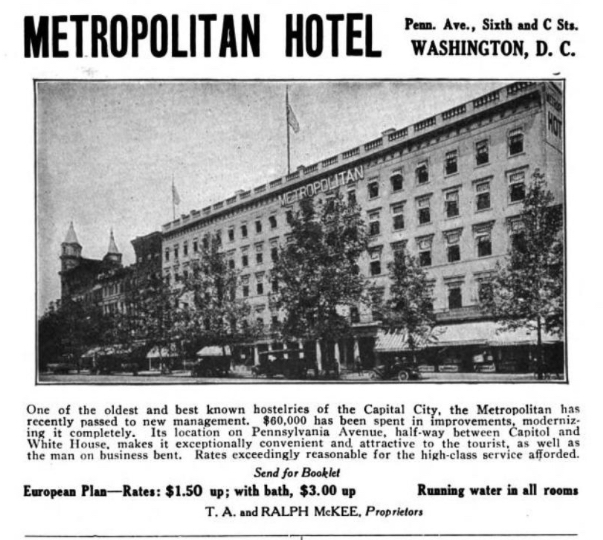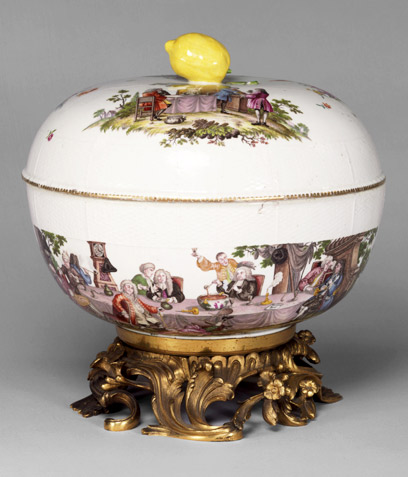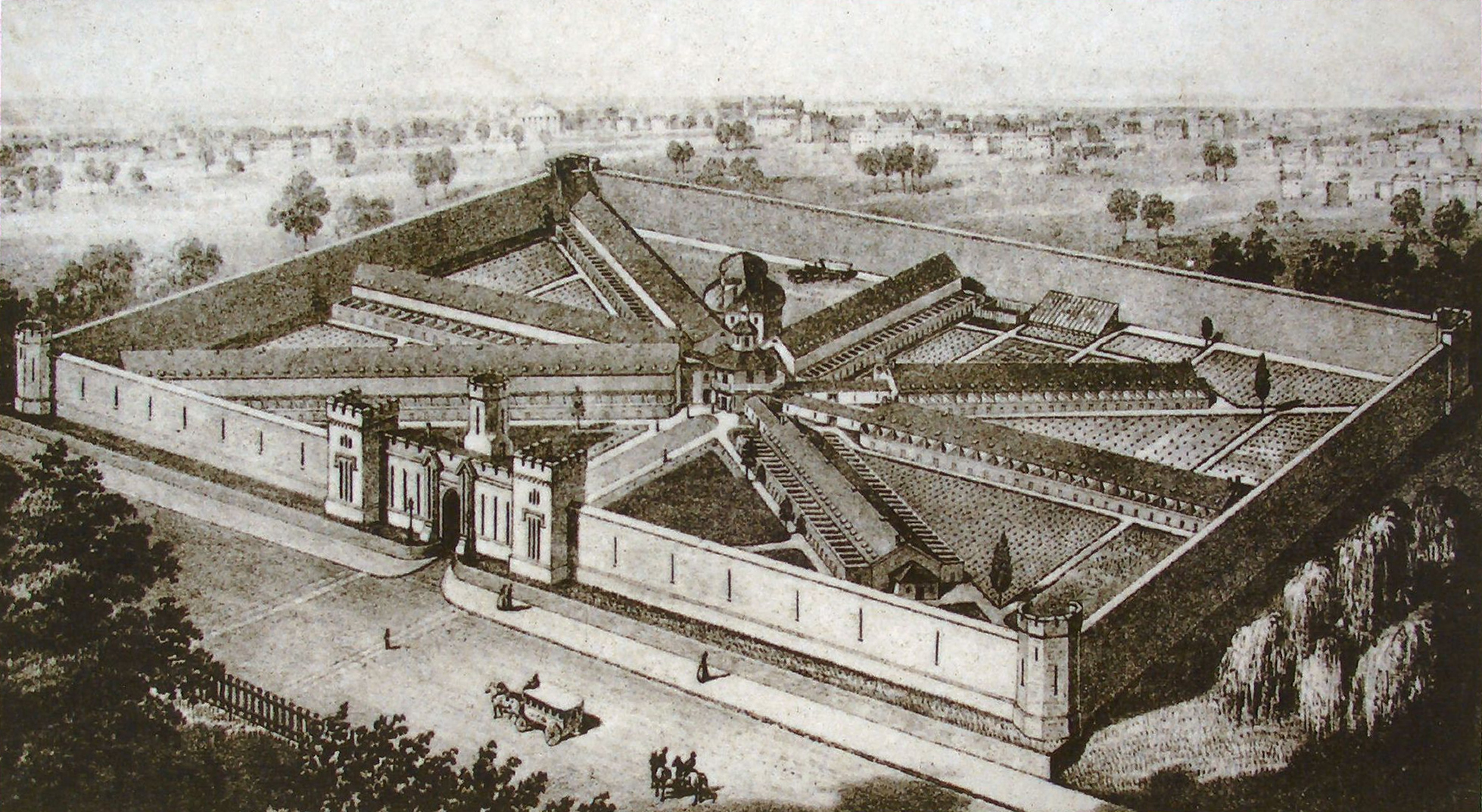|
Metropolitan Hotel (Washington, D.C.)
The Metropolitan Hotel at Pennsylvania Avenue and Sixth Street NW in Washington, D.C. was a major hotel of the capital city of the United States from 1863 to 1933. Built in 1850 by the heirs of Jesse Brown, the Metropolitan was "brick with marble veneer, originally five stories, approx matelytwenty bays." In its day it was home "to many distinguished congressmen and visitors." The Metropolitan had a reputation as the hotel of politicians from the Southern states. History The history of the hotel that stood on Pennsylvania between Sixth and Seventh began with a land purchase in 1802. The first owner constructed Woodward's Centre Tavern and arranged to have water piped to the building from a nearby spring. Successive owner-operators of taverns on the block included Solomon Meyer, Robert Underwood, Nicholas L. Queen, George W. Lindsay, John Davis, and David McKeowin, all of whom built or linked extant structures in various combinations. " The Star-Spangled Banner" was supposedly ... [...More Info...] [...Related Items...] OR: [Wikipedia] [Google] [Baidu] |
Metropolitan Hotel Advertisement Of 1920
Metropolitan may refer to: * Metropolitan area, a region consisting of a densely populated urban core and its less-populated surrounding territories * Metropolitan borough, a form of local government district in England * Metropolitan county, a type of county-level administrative division of England Businesses * Metro-Cammell, previously the Metropolitan Cammell Carriage and Wagon Company * Metropolitan-Vickers, a British heavy electrical engineering company * Metropolitan Stores, a Canadian former department store chain * Metropolitan Books, an imprint of Henry Holt and Company Colleges and universities * Leeds Metropolitan University, United Kingdom * London Metropolitan University, United Kingdom * Manchester Metropolitan University, United Kingdom * Metropolitan Community College (Omaha), United States * Metropolitan State University of Denver, United States ** Metro State Roadrunners * Metropolitan State University, in Saint Paul, Minnesota * Oslo Metropolitan Univer ... [...More Info...] [...Related Items...] OR: [Wikipedia] [Google] [Baidu] |
Punch Bowl
A punch bowl or punchbowl is a bowl, often large and wide, in which the drink punch is served.''The Language of Drink'' Graham and Sue Edwards 1988, Alan Sutton Publishing Origins The word ''punch'' is a loanword from Hindi. The original drink was named ''paantsch'', which is Hindi for "five", and the drink was made from five different ingredients: spirit, sugar, lemon, water or tea and spices. The drink was brought back from India to England by the sailors and employees of the British East India Company in the early seventeenth century, and from there it was introduced into other European countries. Punch bowls Punch quickly became a popular drink. It was served in punch bowls, usually ceramic or silver, which were often elaborately decorated. Punch bowls sometimes had lids or were supported on a stand; other accessories such as a serving ladle and cups in which to serve the drink sometimes accompanied the punch bowl. Punch bowls were often painted with inscriptions or we ... [...More Info...] [...Related Items...] OR: [Wikipedia] [Google] [Baidu] |
Hotels Established In 1850
A hotel is an establishment that provides paid lodging on a short-term basis. Facilities provided inside a hotel room may range from a modest-quality mattress in a small room to large suites with bigger, higher-quality beds, a dresser, a refrigerator and other kitchen facilities, upholstered chairs, a flat screen television, and en-suite bathrooms. Small, lower-priced hotels may offer only the most basic guest services and facilities. Larger, higher-priced hotels may provide additional guest facilities such as a swimming pool, business centre (with computers, printers, and other office equipment), childcare, conference and event facilities, tennis or basketball courts, gymnasium, restaurants, day spa, and social function services. Hotel rooms are usually numbered (or named in some smaller hotels and B&Bs) to allow guests to identify their room. Some boutique, high-end hotels have custom decorated rooms. Some hotels offer meals as part of a room and board arrangement. In Jap ... [...More Info...] [...Related Items...] OR: [Wikipedia] [Google] [Baidu] |
Demolished Hotels In Washington, D
Demolition (also known as razing, cartage, and wrecking) is the science and engineering in safely and efficiently tearing down of buildings and other artificial structures. Demolition contrasts with deconstruction, which involves taking a building apart while carefully preserving valuable elements for reuse purposes. For small buildings, such as houses, that are only two or three stories high, demolition is a rather simple process. The building is pulled down either manually or mechanically using large hydraulic equipment: elevated work platforms, cranes, excavators or bulldozers. Larger buildings may require the use of a wrecking ball, a heavy weight on a cable that is swung by a crane into the side of the buildings. Wrecking balls are especially effective against masonry, but are less easily controlled and often less efficient than other methods. Newer methods may use rotational hydraulic shears and silenced rock-breakers attached to excavators to cut or break through ... [...More Info...] [...Related Items...] OR: [Wikipedia] [Google] [Baidu] |
George Washington House (Bladensburg, Maryland)
The George Washington House, or Indian Queen Tavern, is located at Baltimore Avenue, at Upshur Street, in Bladensburg, Prince George's County, Maryland. It was constructed in the 1760s. The -story structure is constructed of brick Flemish bond on ends. The plan is rectangular, with a gabled roof, exterior end chimneys, gabled shingled dormers. There are first and second-story center entrances, each with a transom. There is a full-width one-story porch with balustraded deck and side entrances. The structure includes a later two-story rear addition. The structure is Georgian. It represents the last remnant of a social and commercial complex established in the 1760s by Jacob Wirt, whose son William Wirt later became U.S. Attorney General and an 1832 presidential candidate. The Indian Queen Tavern gained its reputation as the "George Washington George Washington (February 22, 1732, 1799) was an American military officer, statesman, and Founding Father who served ... [...More Info...] [...Related Items...] OR: [Wikipedia] [Google] [Baidu] |
Kirkwood House (Washington, D
The Kirkwood House is a historic building located in Iowa City, Iowa, United States. It was built for the local attorney and businessman Samuel J. Kirkwood who also served as Governor of Iowa, represented Iowa in the United States Senate, and was Secretary of the Interior in the cabinet of President James A. Garfield. with The house was built after his second term as governor and remained his home until his death in 1893. His widow remained here until her death in 1923. This was his home during most of his political career and it reflects the "rural and unpretentious style of living" that the Kirkwoods preferred. The house was originally located on a much larger estate, but the rest of it has subsequently been divided into lots and sold. The two-story L-shaped wood-frame structure, which sits further back from the street than other houses on the block, has paired brackets and a roof line cornice In architecture, a cornice (from the Italian ''cornice'' meaning ... [...More Info...] [...Related Items...] OR: [Wikipedia] [Google] [Baidu] |
Brown's Marble Hotel 1853
North Fork (formerly Brown's and Northfork; Mono wa?ahhpY', "cedar grove") is a census-designated place (CDP) in Madera County, California, United States. As of the 2020 United States census it had a population of 3,250. It is part of the Madera Metropolitan Statistical Area. The Northfork Rancheria of Mono Indians of California maintains their tribal headquarters in North Fork. Geography North Fork is located in the foothills of the Sierra Nevada at an elevation of . It is north-northeast of Fresno, northeast of Madera, and by road southeast of Oakhurst. According to the U.S. Census Bureau, the North Fork CDP has a total area of , of which , or 0.14%, are water. The community is drained by Willow Creek and by its North Fork and South Fork. Willow Creek is a south-flowing tributary of the San Joaquin River. The geographic center or midpoint of the state of California is located between North Fork and Italian Bar. The point is about driving distance from th ... [...More Info...] [...Related Items...] OR: [Wikipedia] [Google] [Baidu] |
Sherry Cobbler
A sherry cobbler is a classic American cocktail made with sherry, sugar and citrus. Its origins are not known in detail, but is believed to have originated sometime in the early 19th century. The earliest known mention is from an 1838 diary of a Canadian traveler to the United States, Katherine Jane Ellice, but it did not gain international name recognition until Charles Dickens included the drink in ''The Life and Adventures of Martin Chuzzlewit''. To make the drink, orange and lemon are muddled with simple syrup, shaken with ice in a cocktail shaker, and strained into a highball glass filled with crushed ice. Garnishes include mint leaves, raspberry, and orange and lemon slices. It can also be garnished with pineapple wedges or any seasonal berries. Some recipes add pineapple juice. History The Sherry Cobbler emerged during the 1830s and became one of the most popular mixed drinks in the 19th century United States. The invention of the drinking straw around this time made crush ... [...More Info...] [...Related Items...] OR: [Wikipedia] [Google] [Baidu] |
Hot Toddy
A hot toddy, also known as hot whiskey in Ireland, is typically a mixed drink made of liquor and water with honey, (or in some recipes, sugar), lemon, herbs (such as tea) and spices, and served hot. Hot toddy recipes vary and are traditionally drunk before retiring for the night, in wet or cold weather or to relieve the symptoms of the cold and flu. In ''How to Drink'', Victoria Moore describes the drink as "the vitamin C for health, the honey to soothe, the alcohol to numb." Preparation A hot toddy is a mixture of a spirit (usually whisky), hot water, and honey (or, in some recipes, sugar). In Canada, maple syrup may be used. Additional ingredients such as cloves, a lemon slice or cinnamon (in stick or ground form) are often also added. Etymology The word ''toddy'' comes from the toddy drink in India, produced by fermenting the sap of palm trees. Its earliest known use to mean "a beverage made of alcoholic liquor with hot water, sugar, and spices" is from 1786. It is ofte ... [...More Info...] [...Related Items...] OR: [Wikipedia] [Google] [Baidu] |
Julep (cocktail)
Mint julep is a mixed alcoholic drink, or cocktail, consisting primarily of bourbon, sugar, water, crushed or shaved ice, and fresh mint. As a bourbon-based cocktail, it is associated with the American South and the cuisine of the Southern United States in general, and the Kentucky Derby in particular. Preparation A mint julep is traditionally made with four ingredients: mint leaf, bourbon, simple syrup, and crushed ice. Traditionally, spearmint is the mint of choice used in Southern states, and in Kentucky in particular. Proper preparation of the cocktail is commonly debated, as methods may vary considerably from one bartender to another. The mint julep may be considered a member of a loosely associated family of drinks called "smashes" (the brandy smash is another example, as well as the mojito), in which fresh mint and other ingredients are muddled or crushed in preparation for flavoring the finished drink. The step further releases essential oils and juices into the ... [...More Info...] [...Related Items...] OR: [Wikipedia] [Google] [Baidu] |
John Haviland
John Haviland (15 December 1792 – 28 March 1852) was an English-born American architect who was a major figure in American Neo-Classical architecture, and one of the most notable architects working from Philadelphia in the 19th century. Biography Born 15 December 1792, at Gundenham, near Wellington, England, Haviland was apprenticed in 1811 to a London architect. In 1815 he unsuccessfully pursued an appointment to the Russian Imperial Corps of Engineers. In Russia, however, he met George von Sonntag and John Quincy Adams, who encouraged him to work in the United States. He arrived in Philadelphia in 1816, and soon established himself as one of the few professional architects in the city. By 1818, Haviland produced a book, ''The Builder's Assistant'', which appeared in three volumes over several years. This publication was one of the earliest architectural pattern books written and published in North America, and likely the first to include Greek and Roman classical orders. ... [...More Info...] [...Related Items...] OR: [Wikipedia] [Google] [Baidu] |






.jpg)

